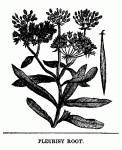OTHER COMMON NAMES—Butterfly weed, Canada-root, Indian-posy, orange-root, orange swallowwort, tuberroot whiteroot, windroot, yellow or orange milkweed.
HABITAT AND RANGE—Pleurisy-Root flourishes in the open or in the pine woods, in dry, sandy or gravelly soil, usually along the banks of streams. Its range extends from Ontario and Maine to Minnesota, south to Florida, Texas and Arizona, but it is found in greatest abundance in the South.
DESCRIPTION OF PLANT—This is a very showy and ornamental perennial plant, indigenous to this country, and belonging to the milkweed family (Asclepiadaceae); it is erect and rather stiff in habit, but with brilliant heads of bright orange-colored flowers that attract attention from afar.
The stems are rather stout, erect, hairy, about 1 to 2 feet in height, sometimes branched near the top, and bearing a thick growth of leaves. These are either stemless or borne on short stems, are somewhat rough to the touch, 2 to 6 inches long, lance shaped or oblong, the apex either sharp pointed or blunt, with a narrow, rounded or heart shaped base. The flower beads, borne at the ends of the stem and branches, consist of numerous, oddly shaped orange colored flowers. The corolla is composed of five segments, which are reflexed or turned back and the crown has five erect or spreading "hoods," within each of which is a slender incurved horn. The plant is in flower for some time, usually from June to September, followed late in the fall by pods, which are from 4 to 5 inches long, green, tinged with red, finely hairy on the outside, and containing the seeds with their long, silky hairs. Unlike the other milkweeds, the Pleurisy Root contains little or no milky juice.
DESCRIPTION OF ROOT—The root of this plant is large, white and fleshy, spindle shaped, branching. As found in commerce it consists of lengthwise or crosswise pieces from 1 to 6 inches in length and about three-fourths of an inch in thickness. It is wrinkled lengthwise and also transversely and has a knotty head. The thin bark is orange brown and the wood yellowish, with white rays. It has no odor and a somewhat bitter, acrid taste.
COLLECTION, PRICES AND USES—The root, which is usually found rather deep in the soil, is collected in autumn, cut into transverse or lengthwise slices and dried. The price ranges from 6 to 10 cents a pound.
Pleurisy Root was much esteemed by the Indians, has long been used in domestic practice, and is official in the United States Pharmacopoeia. It is used in disordered digestion and in affections of the lungs, in the last-named instance to promote expectoration, relieve pains in the chest, and induce easier breathing. It is also useful in producing perspiration.
OTHER SPECIES—Besides the official Pleurisy Root there are two other species of Asclepias which are employed to some extent for the same purposes, namely, the common milkweed and the swamp-milkweed.
The common milkweed (Asclepias syriaca L.) is a perennial, native in fields and waste places from Canada to North Carolina and Kansas. It has a stout, usually simple stem 3 to 5 feet in height and oblong or oval leaves, smooth on the upper surface and densely hairy beneath. The flowers, similar in form to those of Asclepias tuberosa, are pinkish purple and appear from June to August, followed by erect pods 3 to 5 inches long, woolly with matted hair and covered with prickles and borne on recurved stems. The plant contains an abundance of milky juice.
The root of the common milkweed is from 1 to 6 feet long, cylindrical and finely wrinkled. The short branches and scars left by former stems give the root a round, knotty appearance. The bark is thick, grayish brown and the inside white, the root breaking with a short, splintery fracture. Common milkweed root has a very bitter taste, but no odor.
It is collected in autumn and cut into transverse slices before drying. Common milkweed ranges from 6 to 8 cents a pound.
Swamp-milkweed (Asclepias incarnata L.) is a native perennial herb found in swamps from Canada to Tennessee and Kansas. The slender stem, leafy to the top, is 1 to 2 feet in height, branched above, the leaves lance shaped or oblong lance shaped. The flowers, also similar to those of tuberosa, appear from July to September, and are flesh colored or rose colored. The pods are 2 to 31 inches long, erect, and very sparingly hairy.
The root of the swamp-milkweed, which is also collected in autumn, is not quite an inch in length, hard and knotty, with several light brown rootlets. The tough white wood, which has a thick, central pith, is covered with a thin, yellowish brown bark. It is practically without odor, and the taste, sweetish at first, finally becomes bitter. This root brings about 3 cents a pound.
Ginseng and Other Medicinal Plants, 1936, was written by A. R. Harding.


